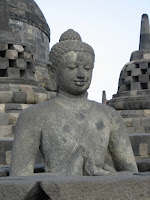Further on, we visited the Bird Market. A slightly sorry affair where animal welfare officers would have had a busy time. Now, my Mum has always warned me about strange men inviting me to see their puppy dogs. But what do you do when someone invites you to see some snakes? Our instant friend took us to see the collection of reptiles which he 'owned'. These pythons were huge and, unfortunately, not kept in anything resembling their natural habitat.
Our new found friend then took us on a tour of the Taman Sari or Water Castle. A war and a couple of earthquakes have reduced much of building to ruins. However, several parts have been restored including an underground mosque and the tunnel leading to the palace. Here, the sultan entertained his harem.


On our return, it transpired that our guide neither worked in the Bird Market nor was a professional guide for the area (but he did give a good tour). The hard sell then started, turning into comedy as 'expensive' batik paintings started falling over. There was even a sharp intake of breath when we suggested that some of the paintings might have been printed. After what seemed like an eternity, we made vague excuses about wanting to catch the sunset and left.



On our last day in Jogja, we visited the nearby Prambanan temple complex, easily reached by the Trans-Jogja public bus (1A). The area houses an impressive collection of Hindu and Buddhist temples built over 1,000 years ago. Although damaged by earthquakes – most recently in 2006 – the site has undergone a series of restorations and is listed as a World Heritage Site.


Highlights of Jogja have also included the doughnut shop in the mall which has a viewable doughnut production line. Doughnuts can be bought in boxes of 24, and we saw people buying multiples of these boxes. That said, they did look like regular customers! The staff were surprised that we only wanted one doughnut each (this is in addition to the free doughnut which accompanies every drink)...

With only three days left in Indonesia, its off to Bandung and then onto Jakarta. From there, we fly to India on 29 July. Our next posting may be a few days after arriving, so expect radio silence until then.














